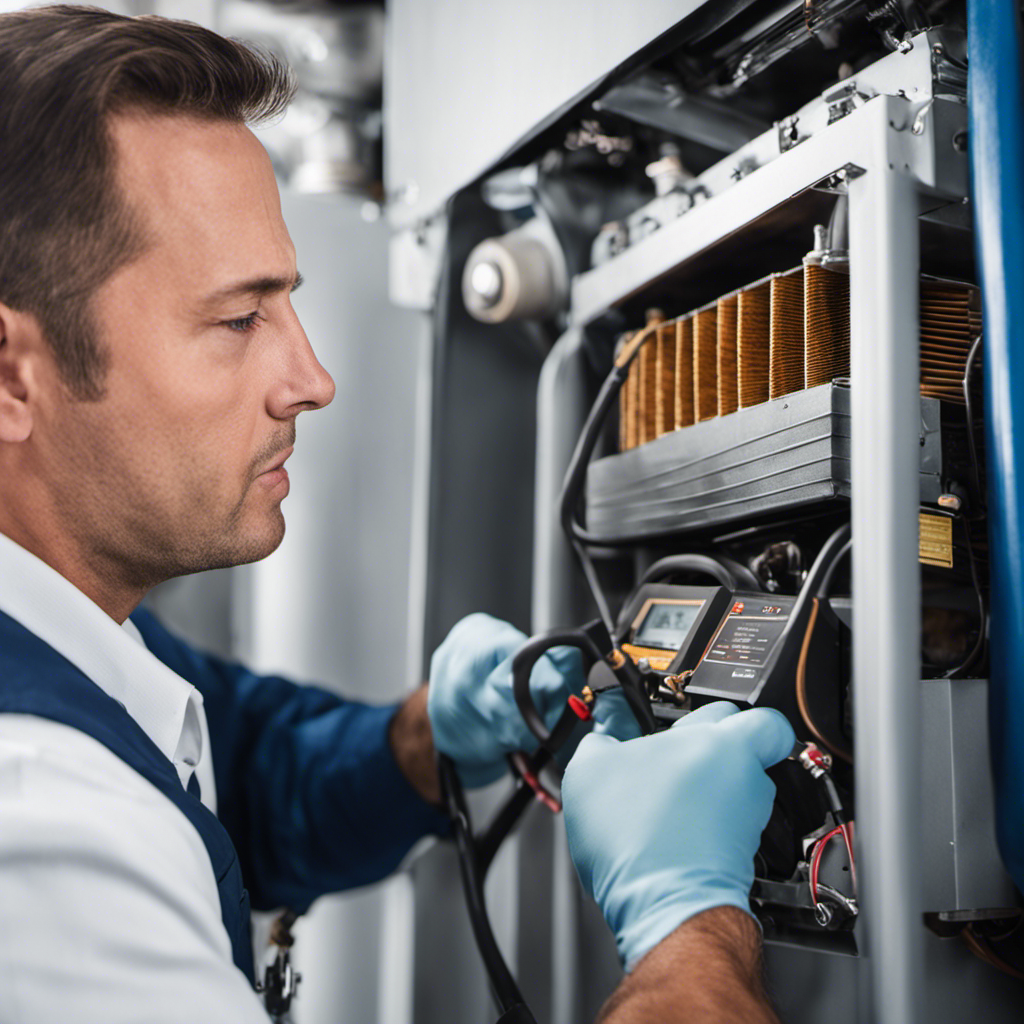Is your furnace ready to handle the cold winter months?
Proper furnace maintenance is essential to ensure its optimal performance and longevity.
This article provides valuable tips on how to prepare your furnace for winter.
From checking and cleaning air filters to inspecting vents and ducts, we’ll guide you through the necessary steps to achieve a warm and comfortable home.
Don’t overlook the importance of professional furnace inspection and tune-up services to guarantee your system’s efficiency and reliability.
Key Takeaways
- Regular furnace maintenance ensures optimal performance and extends its lifespan.
- Checking and cleaning air filters regularly improves indoor air quality and prevents breakdowns.
- Inspecting and cleaning vents and ducts maintain optimal airflow and prevent ventilation issues.
- Testing thermostat functions and ensuring proper airflow and ventilation are essential for efficient operation and energy savings.
Importance of Furnace Maintenance
When it comes to the proper functioning and longevity of your furnace, the importance of regular maintenance cannot be overstated. Regular maintenance not only ensures that your furnace operates at peak performance but also helps in extending its lifespan.
One of the key benefits of furnace maintenance is improved energy efficiency. A well-maintained furnace will consume less energy to provide the same level of heating, resulting in lower energy bills.
Additionally, regular maintenance helps identify and fix any potential issues before they escalate into major problems. This proactive approach not only saves you from costly repairs but also ensures that your furnace operates smoothly throughout the winter season.
Therefore, investing in regular furnace maintenance is essential for both energy efficiency and extending the lifespan of your furnace.
Checking and Cleaning Air Filters
To ensure optimal performance, it is important to regularly check and clean the air filters of your furnace. Air filters play a crucial role in maintaining good indoor air quality and keeping your furnace running efficiently.
Over time, filters can become clogged with dust, dirt, and other particles, which can restrict airflow and reduce the efficiency of your furnace. By replacing filters on a regular basis, you can improve indoor air quality and ensure that your furnace is running at its best.
Cleaning air filters also helps to prolong the lifespan of your furnace and prevent potential breakdowns. It is recommended to check and clean your air filters at least once every three months, or more frequently if you have pets or allergies.
Inspecting and Cleaning Vents and Ducts
Regularly inspecting and cleaning both the vents and ducts of your furnace is essential for maintaining optimal airflow and ensuring the efficient functioning of your heating system. When it comes to cleaning techniques, it is important to use the right tools and follow proper procedures.
Start by removing any visible dust or debris from the vents using a vacuum cleaner or a soft brush. For a more thorough cleaning, consider hiring a professional duct cleaning service every few years.
Additionally, pay attention to any signs of ventilation issues, such as reduced airflow, strange odors, or excessive dust accumulation in your home. These could indicate the need for a more immediate inspection and cleaning of your vents and ducts.
Testing Thermostat Functions
One important step in preparing your furnace for winter is verifying the accuracy and functionality of your thermostat. A properly calibrated thermostat ensures that your furnace operates efficiently and maintains a comfortable temperature in your home.
To begin, check if your thermostat is displaying the correct temperature. You can use a thermometer to compare the reading on your thermostat. If there is a discrepancy, you may need to calibrate it by following the manufacturer’s instructions.
Additionally, familiarize yourself with the troubleshooting techniques for common thermostat issues. These may include checking the batteries, resetting the thermostat, or cleaning the contacts.
Ensuring Proper Airflow and Ventilation
First and foremost, it is essential to regularly inspect and clean the air ducts and vents in your home to ensure proper airflow and ventilation for your furnace during the winter months. Maximizing efficiency and preventing heat loss are crucial for the effective functioning of your furnace.
Clogged or dirty air ducts can restrict airflow, causing your furnace to work harder and consume more energy. By cleaning and removing any debris or dust from the ducts and vents, you can ensure that your furnace operates at its optimal efficiency.
Additionally, it is important to check for any leaks or gaps in the ductwork that may lead to heat loss. Sealing these gaps can prevent the escape of warm air, ensuring that your home stays cozy and comfortable during the winter season.
Professional Furnace Inspection and Tune-Up
How can you ensure that your furnace is in optimal condition for the winter season by scheduling a professional furnace inspection and tune-up?
Professional furnace repair technicians are trained to identify and address common furnace issues that may affect the performance and efficiency of your heating system.
By scheduling a professional inspection and tune-up, you can rest assured knowing that your furnace is in the hands of experts who will thoroughly assess its components, clean and lubricate moving parts, and make any necessary repairs or adjustments.
This proactive approach not only helps prevent unexpected breakdowns during the cold winter months but also ensures that your furnace operates efficiently, saving you money on energy bills.
Don’t wait until your furnace stops working, schedule a professional inspection and tune-up today to keep your home warm and comfortable all winter long.
Frequently Asked Questions
How Often Should I Replace My Furnace?
The frequency of furnace replacement depends on various factors such as the age, condition, and maintenance of the furnace. Regular maintenance, including addressing common furnace problems, can help extend the lifespan of your furnace.
What Are Signs That My Furnace Is Not Functioning Properly?
Common furnace problems can include inadequate heating, strange noises, frequent cycling, and increased energy bills. To troubleshoot these issues, homeowners should check the thermostat, inspect the air filters, and schedule regular maintenance with a professional HVAC technician.
Can I Clean My Furnace Myself, or Do I Need to Hire a Professional?
DIY furnace cleaning can be done, but hiring a professional offers several benefits, such as ensuring thorough cleaning, identifying potential issues, and maintaining warranty. Professionals possess the necessary expertise and tools for optimal furnace maintenance.
How Can I Improve the Energy Efficiency of My Furnace?
To improve the energy efficiency of your furnace, consider implementing energy-saving tips such as regular furnace maintenance, cleaning or replacing air filters, sealing air leaks, and scheduling professional inspections and tune-ups.
Are There Any Safety Precautions I Should Take When Preparing My Furnace for Winter?
When preparing your furnace for winter, it is important to take safety precautions and follow maintenance tips to ensure its optimal performance. This includes checking for gas leaks, cleaning or replacing filters, and scheduling professional inspections.


